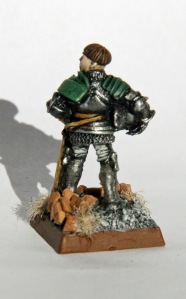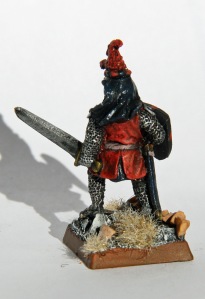A few weeks ago, before everything was shut down here in Denmark, we had the chance to play the first scenario in the Circle of Blood campaign published by Games Workshop in 1997 for WFB 5th ed. and written by Warhammer luminaires Tuomas Pirinen and Jake Thornton. I don’t play 5th ed. but the campaign is easily transposed back to our retro universe of WFB 3rd ed, which I thus did.
The campaign basically consists of four linked scenarios; three minor encounters and one grand finale. The backstory revolves around the so-called Red Duke – a vampire knight banished to his grave centuries ago in Bretonnia. The Red Duke has now risen again and seeks to overthrow Aquitaine and have his revenge on all mortals. It is up to the knights and men-at-arms of Aquitaine to prevent The Red Duke from gathering his forces and butchering the realm.
The outcome of the first three scenarios has a direct influence on the last, final battle, which gives a nice sense of continuity to the proceedings.
The first scenario is dealing with the necromancer Renar, who has travelled to the village of Mercal, where a number of The Red Duke’s knights are imprisoned by magic in a moldering mausoleum. The inhabitants of the village have been able to gather a small force to defend the village and graveyard from the undead and they thus stand ready when the dead arrive to reclaim their lost comrades. The undead force is, of course, spearheaded by the necromancer Renar, while the defense of Mercal is led by the so-called Holy Knight Albert Lainnon and his second in command Jean-Paul Fabez.
In this first encounter a few special rules apply, which I twisted slightly to fit our 3rd ed. rendition of the campaign. First of all Renar instantly wins the battle if he is able to cast the spell Summon Undead Hero while in base contact with the mausoleum. Secondly The Holy Knight Albert is in possession of the blessed Shield of Virtue, which prevents any necromantic spells to be cast within 6” of him. Finally the scenario takes place at night. Each turn 4D6 is rolled to determine how far in inches the Bretonnians and Renar can see, which of course applies to charges, casting spells and shooting.
I was initially a bit concerned with this scenario as the forces begin very close together and it seemed like a fairly simple thing for Renar to scurry up to the mausoleum and cast his spell. Measured in distance only he would be able to win the scenario in two turns. However, it proved really difficult for him and I must say, that this really is a fine little scenario with a lot of tactical elements as well as a fun narrative. The magic of The Holy Knight’s shield prevented him from simply casting his spell and the undead had to kill or drive off the knight before they could succeed. This they also nearly did, but in the end the Bretonnians won the battle by killing Renar.
It was a close and really exiting battle played in little over two hours. The darkness definitely worked to the advantage of the undead, rendering the Bretonnian archers almost useless and making it very hard for the knights and their mounted retainers to make use of their long movement range. This could easily have been won by the undead, but the Bretonnians won, which means that The Red Duke now has to rely on the named characters from the scenarios, as he is not allowed to include any additional heroes in his army during the last scenario, whereas the Holy Knight will fight again during this last combat.
If interested, these were the rosters we used: The Holy Knight_roster and Renar_roster.
This is how it all looked when presented in a bit random fashion:























































